#carcassone
Explore tagged Tumblr posts
Text
Messing about with wave function collapse using some scanned Carcassone tiles. Oddly fascinating to watch.
6 notes
·
View notes
Text
La Cité, the fortress

The Citadel of Carcassonne (Ciutat de Carcassona in Occitan) is a medieval fortress located in the town of the same name in Occitania. The fortress is a symbol of the region and one of the most visited tourist attractions in France.
The history of the Citadel of Carcassonne dates back to the Gallo-Roman period, when the Romans established a military camp on the site to protect the region from invasion. The camp was subsequently abandoned and the site remained unused for several centuries.
In the 12th century, the fortress was built by the Viscounts of Carcassonne, powerful feudal lords of the region after the extinction of the county whose holders were the sovereigns of Barcelona, whose first counts originated from this fief. It was conceived as a bulwark against the invading French forces during the Albigensian Crusade, a military campaign launched by the Catholic Church against the Cathar heresy, which had settled in the region.
The fortress was built in two parts: the inner castle, known as the Château Comtal, and the outer ramparts surrounding the town. The castle was built first and was intended to be the residence of the viscounts. Later the outer ramparts were added to protect the town and the castle.
The fortress suffered several sieges. One of the most famous of these took place in 1209 during the Albigensian Crusade, when it was besieged for several months, after which it fell to the French.
The fortress was further reinforced in the 13th century, during the reign of the saintly King Louis IX of France. The king ordered the construction of several additional towers and fortifications to protect the town from attack.
However, after the incorporation of the semi-independent Occitan fiefs into the Kingdom of France, the fortress lost its military importance and was gradually abandoned. By the 19th century, it had fallen into disrepair and was in danger of being demolished.
In the 1850s, the French architect Eugène Viollet-le-Duc was commissioned to restore the fortress to its former splendour. Viollet-le-Duc supervised the restoration and added several new elements, such as the pointed roof of the towers, which were not part of the original design.
The restoration was completed in the early 20th century and it was opened to the public. Today, the Citadel of Carcassonne is one of the most visited tourist attractions in France, attracting millions of visitors each year. It has also been recognised as a UNESCO World Heritage Site for its historical and cultural importance.
3 notes
·
View notes
Text
Canzone nata da venerdi' sera molto nerd, fatta da un mio amico geniale
0 notes
Text

#carcassone#insumos#mercearias#produtos#exportação#history#esportation#wool#algodão#dourado#peças#game pieces
0 notes
Text
#antiguos posts#archive#francia#vidrieras#France#Stained-glass windows#En Español#In English#Carcasona#Carcassone#arquitectura#artes decorativas
0 notes
Text
ppl talk abt financial liquidity but nobody talks about carcassone meeple liquidity which is an important factor in deciding to commit your unused meeples to new resources.
0 notes
Text
lil guys of nwomn


Moishe Feinstein-Moskovich

Eliyahu Rosenthal

Mordechai Fernandez-Chavez

Eun-Ji Allard-Kook

Avishai Teherani

Esther Mendelssohn

Aureliana Carcassone

Xingyi Zhao

Aviyah Ezra

Oluwaseyi Adebayo

Roimata Paewai

Osawkihew Cohen
#Nwomn#my ocs <3#Squishy versions#New Men with Old Man Names#moishe feinstein moskovich#eliyahu rosenthal#roimata paewai#oluwaseyi adebayo#osawkihew cohen#eun ji allard kook#esther mendelssohn#aviyah ezra#mordechai fernandez-chavez#aureliana carcassone#xingyi zhao#avishai teherani#all of them are trans Jews :3#oc art#orignal character#jewish artist#jewish characters#trans artist#trans character#trans#transgender#lgbtq#queer artist#careful or I'll infodump about them lmao
4 notes
·
View notes
Text

Some lazy brush practice. Zura has BIG Noel Fielding energy.
#gintama#gintama fanart#my art#sakata gintoki#zura#Taskmaster's finally back I love Nick Mohamed doing little runs in his Dracula costume#Zura = big Noel Fielding energy#lazy one today 'cause i'm going to celebrate my niece's play the game of life day (well carcassone but hey)#gintama x taskmaster
5 notes
·
View notes
Note
Hey bestie whats a narrow boat? I saw you tag that on something you reblogged and I'm pretty curious now!
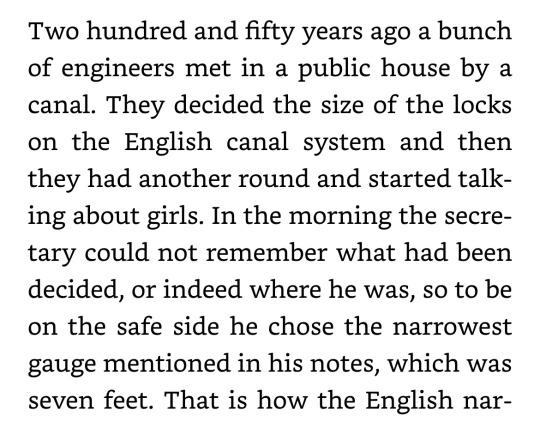


- Terry Darlington, Narrow Dog to Carcassone
A narrowboat (all one word) is a craft restricted to the British Isles, which are connected all over by a nerve-map of human-made canals. To go up and down hills, the canals are spangled with locks (chambers in which boats can be raised or lowered by filling or emptying them with water.) As Terry says above, the width of the locks was somewhat randomly determined, and as a result, the British Isles have a narrow design of lock - and a narrowboat to fit through them. A classic design was seventy feet long and six feet wide. Starting in the 18th century, and competing directly with trains, canal “barges” were an active means of transport and shipping. They were initially pulled along the towpaths by horses, and you can still see some today!
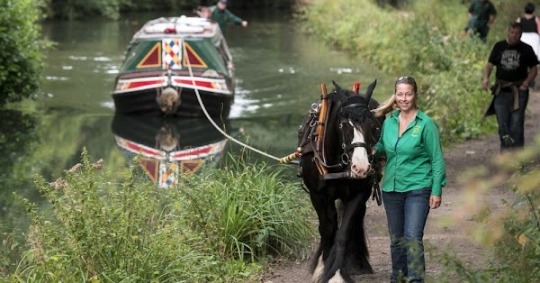
Later, engines were developed.
Even after the trains won the arms race, it was a fairly viable freight service right up until WW2. It’s slow travel, but uses few resources and requires little human power, with a fairly small crew (of women, in WW2) being capable of shifting two fully laden boats without consuming much fossil fuel.
In those times the barges were designed with small, cramped cabins in which the boaters and their families could live.
During its heyday the narrowboat community developed a style of folk art called “roses and castles” with clear links to fairground art as well as Romani caravan decor. They are historically decorated with different kinds of brass ornaments, and inside the cabins could also be distinctively painted and decorated.
Today, many narrowboats are distinctively decorated and colorful - even if not directly traditional with “roses and castles” they’ll still be bright and offbeat. A quirky name is necessary. All narrowboats, being boats, are female.
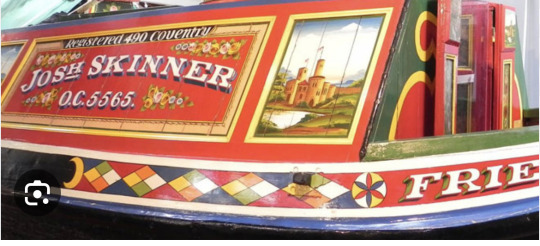

After a postwar decline, interest in the waterways was sparked by a leisure movement and collapsing canals were repaired. Today, the towpaths are a convenient walking/biking trail for people, as they connect up a lot of the mainland of the UK, hitting towns and cities. Although the restored canals are concrete-bottomed, they’re attractive to wildlife. Narrowboats from the 1970s onward started being designed for pleasure and long-term living. People enjoy vacationing by hiring a boat and visiting towns for a cuter, comfier, slower version of a campervan life. And a liveaboard community sprang up - people who live full-time on boats. Up until the very restrictive and nasty laws recently passed in the UK to make it harder for travelling peoples (these were aimed nastily at vanlivers and the Romani, and successfully hit everyone) this was one of the few legal ways remaining to be a total nomad in the UK.
Liveaboards can moor up anywhere along the canal for 28 days, but have to keep moving every 28 days. (Although sorting out the toilet and loading up with fresh water means that a lot of people move more frequently than that.) you can also live full-time in a marina if they allow it, or purchase your own mooring. In London, where canal boats are one of the few remaining cheapish ways to live, boats with moorings fetch the same prices as houses. It can be very very hard for families to balance school, parking, work, and all the difficulties of living off-grid- but many make it work. It remains a diverse community and is even growing, due to housing pressures in the UK. Boats can be very comfortable, even when only six feet wide. When faced with spending thousands of pounds on rent OR mooring up on a nice canal, you can see why it seems a romantic proposition for young people, and UK television channels always have slice-of-life documentaries about young folks fixing up their very own quirky solar-powered narrowboat. I don’t hate; I did it myself.
If you’re lucky, you might even meet some of the cool folks who run businesses from their narrowboats: canal-side walkers enjoy bookshops, vegan bakeries, ice-cream boats, restaurants, artists and crafters. There are Floating Markets and narrowboat festivals. It’s generally recognised that boaters contribute quite a lot to the canal - yet there are many tensions between different kinds of boaters (liveaboards vs leisure boaters vs tourists) as well as tensions with local settled people, towpath users like cyclists, and fishermen. I could go on and on explaining this rich culture and dramas, but I won’t.
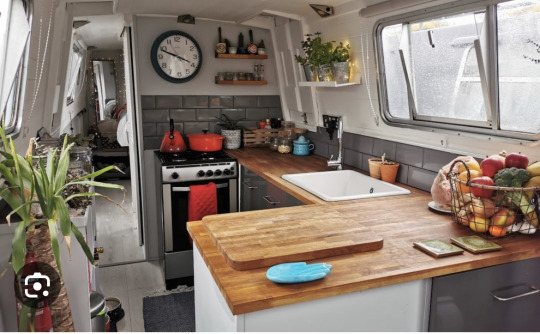
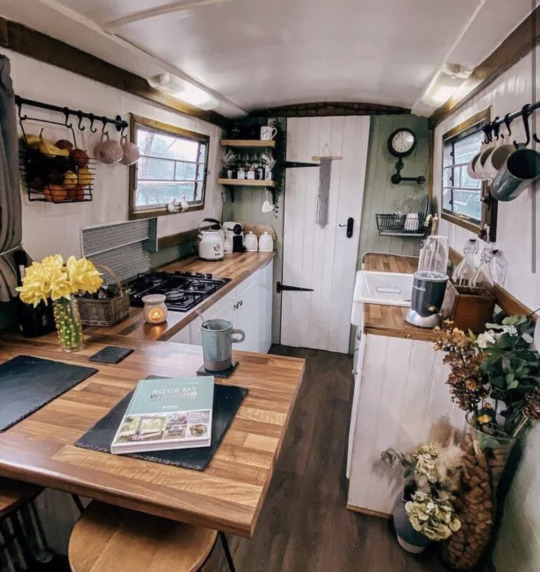
Phillip Pullman’s Gyptians are a commonly cited example of liveaboards - although they were based on the narrowboat liveaboards that Pullman knew in Oxford, their boats are actually Dutch barges. Dutch barges make good homes but are too wide to access most of the midlands and northern canals, and are usually restricted to the south of the UK. So they’re accurate for Bristol/London/Oxford, and barges are definitely comfier to film on. (Being six feet wide is definitely super awkward for a boat.) but in general Dutch barges are less common, more expensive and can’t navigate the whole system.

However, apart from them, there are few examples of narrowboat depictions that escaped containment. So it’s quite interesting that there is an entire indigenous special class of boat, distinctive and highly specialised and very cute, with an associated culture and heritage and folk art type, known to all and widely celebrated, and ABSOLUTELY UNKNOWN outside of the UK - a nation largely known around the world for inflicting its culture on others. They’re a strange, sweet little secret - and nobody who has ever loved one can resist pointing them out for the rest of their lives, or talking about them when asked to. Thank you for asking me to.
6K notes
·
View notes
Text
There's also the fact you're both children relatively close in age and you know fuckall about predictive thinking and the consequesnces of your actions. You're learning all these things with each other and on each other.
Anyways. There's an infinite variations of siblings relationships but if we're talking about fiction, there should be some sort of balance.
You can tortment your sibling but then you gotta help them with homework. You can spend 2 hours pissing them off by hovering in the doorway to their room but you also gotta ignore them for just as long because after a lifetime spent in close quarters they're about as interesting as a dining table. You can not snitch on them, or you can snitch on them, depending on what's in it for you. You can scream and fight, but you also gotta forgive and forget.
It's the variety that makes a relationship "realistic". imo.
Why do people in this fandom hate their siblings??
"I want a realistic sibling-relationship between Regulus and Sirius- i want them to to scream and fight and argue"
I can't remember the last time me and my sibling fought. Just... Them being nice to each other IS realistic if you're not assholes on purpose 🤨
#Regulus and Sirius yelling at each other can be so >>>>> but they gotta be able to separate and pretend it never happened after#until the next time they're fighing them they'll start pulling out grudges from way back in the kindregarden#i still remind my sis of that time she ROBBED ME in monopoly and she brings up when i cheated in carcassone
170 notes
·
View notes
Text
Dad! König
aka a bit of german speaking parenting traditions
when his kids were young he was one of those parents that always sat around the playground with a coffee, watching his kids climbing and doing tricks. naturally he nodded supportively and hummed tiredly every time they showed him a trick.
was the default parent to go to parent's conference days when he could meaning he somehow managed to fold himself up on tiny kids chairs while listing to a teacher talk about school life and his kids progress
always dragged his kids into the outdoors on the weekend to make them work off some energy as he is a firm believer of the classical german "leaving the house once a day"-rule. it gracefully also doubled as giving his partner a bit of alone time.
the parent to push for games night. From Uno to Ludo to Carcassone - an evening playing with his kids, is a good evening.
does not baby his kids. if they get hurt, that's unfortunate and he will try to comfort as much as possible. but getting hurts happens and it's part of growing up. he is not too worried after checking for injury and blowing away the fright with a kiss.
as such he allows for independence and leaves kids to play on their own a lot with a trusted adult being only somewhere in the area depending on the kids age and needs.
the parent to be pleaded with. with enough puppy eyes his kids could get anything from him.
will always push for education over work and as he has the means he will finance whatever is needed for that.
is one of those dads that insists on checking homework when his kids were younger as well as practicing multiplication tables with them.
insists on living in an area where kids can go to school or visit friends on their own from a young age.
limits screen time until they get a bit older.
however they have a phone so he can reach them especially as he travels a lot.
generally regretful on how much he misses and tries to make up on it once he is back.
def the parent to watch kids cartoons with a passion. he can sing along to the bluey intro song at this point.
really bad at crafts with the kids.
will def become a bit awkward once his kids grow older.
will not put up dating rules for his kids no matter the age. they are old enough (and he would also feel weird about it). plus, as he comes from a pro-sex education culture and insists on the same for his kids, he is not too worried about kids doing something they don't understand the consequences of.
he will however insist on his kids telling him where they are once they are older and be home on time.
the parent to call at night to pick up from an escalated party who doesn't judge alcohol consumption. he had his fair share of mishaps and is sympathetic. he will however make some teasing jokes the next day.
will feel lost and uncomfortably old once his kids have moved out but maybe, maybe... one might have grandkids one day and he is patient enough. He has things to do after all. The house needs to be kept up. And the garden needs work. And what about his partner always wanting to travel more?
192 notes
·
View notes
Note
(Hope it's cool asking random stuff) headcanon time: Which boardgame do the Rogues like? Also, which one(s) is banned from game night?
It's always cool! First off, we've canonically seen Mark playing a version of Monopoly, and Evan played what I think was Risk ("Mirror Master will capture France."). Evan has also mentioned Snakes and Ladders by comparing the game to his fights with the Flash.
I think Monopoly, Risk, Ticket To Ride, and Stratego would generally be popular games amongst the Rogues, TBH, and probably their more common go-to games with broad appeal.
Trivial Pursuit is also extremely popular amongst the Rogues, because the usual suspects want to look smart and the others enjoy it when they fail.
Lisa is utterly ruthless when she plays Monopoly, and truthfully, any competitive game. She goes easy on no one, not even her brother or boyfriend.
Digger is mostly into these games for shit-stirring to have a few laughs. Monopoly is the only game he personally enjoys.
Snakes and Ladders is Axel's jam. He likes to loudly cheer at his own good luck and jeer at others' bad luck, and the others find this deeply annoying.
Roscoe loves Scrabble and is a completely insufferable pedant about it, so it's rare that anyone wants to play with him, with one exception. Mark loves it too, and is basically the only person who'll play with him…and also acts pretty similarly. So you've got these two wordy pedantic assholes and it's no fun to play against them, but it's great to watch them frustrate each other.
Most Rogues find stuff like The Game Of Life and Sorry! boring, but Mick enjoys them more than the games that are popular amongst the Rogues.
Roscoe also likes Carcassone and Catan, because that kind of meticulous world-building appeals to him (and absorbs him enough that he doesn't usually act like a jerk while playing). Hartley and Sam are also fans of these games too, but most other Rogues find them dull.
As for who's banned, well Digger cycles through being banned and unbanned, depending on how he's behaving, but every single Rogue has to be watched for cheating. Every single one. Anybody who's been bad at it and gets caught often enough will suffer temporary bans, at least until everybody forgets about it…which might happen when one or two other Rogues get caught cheating and the cycle begins again.


Feel free to add your own headcanons!
#tricksterrune#Weather Wizard#Mirror Master#Golden Glider#Captain Boomerang#the Trickster#Axel#Evan#the Top#Heat Wave#Pied Piper#words#Chronos#Merlyn#Count Vertigo#Killer Frost#various headcanons
20 notes
·
View notes
Text
Hello, I’m Charity!
I’m new to Tumblr but looking forward to finding new interests and sharing current ones.
Some of my current interests: Wicked, Arcane, and Steven Universe!
Music and musical theatre are my passions in life. I enjoy Sammy Rae & the Friends and Hozier most. Falsettos and Waitress are my all-time favorite musicals. I recently started taking voice lessons again to get in touch with my instrument… hoping to begin dance lessons too :)
I would like to watch more anime, but struggle with some of the depictions of women… and of gore… so very little left to explore after this hahah (please send recommendations if they don’t have these things i beg of you)
I enjoy gaming, but I’m not very skilled. I stick to things like Sims 4, Minecraft, etc. but I want to diversify this more. I recently started Lake on PC and it has been a lot of fun. I like playing Legend of Zelda: Breath of the Wild, but I’m terrible with fighting games and lose motivation when I struggle… so little progress has been made.
I enjoy some physical games like Here to Slay and Carcassone! I would like to play Dungeons and Dragons but I am still learning/trying to understand and lack people to start a campaign with.
I’m neurodivergent (OCD) and going through a healing journey in my life right now (even as much as I don’t want to admit I am) and extremely resonate with the phrase “knew everything at 18 and nothing at 22” lol
Every day hobbies include digital art, junk journaling, collecting DVD’s & CD’s, reading, and writing. Recently purchased air dry clay and coloring books and markers.
It’s been nice to have fun things to do. I stopped allowing myself to have interests or hobbies for quite a few years. So I’m kind of trying to teach myself how to even enjoy shows and games and media again. Thanks for reading a little about me. I’d love to hear about the shows and movies and games and more you love and why you love them! xx
#arcane#wicked#steven universe#sammy rae & the friends#hozier#greys anatomy#the good place#breaking bad#gravity falls#ouran host club#yuri on ice#your lie in april#demon slayer#platinum end#boys in the band#waitress#falsettos#the last of us
9 notes
·
View notes
Text
LMAO Armand would feel utterly betrayed but it's the only way to beat him. You know somehow he has Boardwalk *and* Park Place with massive hotels, he's managed to trade for all the utilities, and the board is now a minefield of Armand's properties. And if they try to quit and call Armand the winner, he will insist the game is not over yet. (Although getting Lestat to concede and quit would be a feat in an of itself. He'd probably flip the table first.) Working together to defeat him is the only way! 😭😂

@desertfangs - I didn’t want to derail op’s post but this made me think of your fic 😭 peek Daniel and Lestat teaming up in Monopoly to defeat Armand (to his complete and utter horror)
#coven game night#the vampires playing board games is one of my favorite things#i imagine it happens once every few years and then they vow NEVER AGAIN#until armand gets hooked on carcassone or something and forces them all into it again#armand#daniel molloy#lestat de lioncourt#armand/daniel#armand/lestat#lestat/daniel#vc headcanons#vc#vampire chronicles#this post makes me so happy!!#the vampire chronicles
14 notes
·
View notes
Text
Evaludate Episode 99: The Devil Is Real (Tyril I Lister of even if Tempest, Part 1)
Summary:
On today's TWO HOUR EVALUDATE SPECIAL, we're getting into the real-world history of witch hunting and witch trials around Europe and North America, Madelyn insists that everyone else insisting that she would like Tyril is still wrong, and being a murder suspect is boring now--it's time to get deputized.
Content Warnings:
Discussion of antisemitism and islamophobia: 13:23 - 14:45, 54:28 - 54:55
Sexual Assault: 25:17 - 25:59
Emetophobia: 1:06:08 - 1:07:31
CSA: 1:16:50 - 1:17:20
Suicide: 1:16:50 - 1:17:20
Incest: 1:30:43 - 1:31:05, 1:34:04 - 1:34:16
Corrections, Notes, and Sources:
Air misspoke when saying Pope John XXII’s declaration of witchcraft as heresy in 1320 took the form of a papal bull. Though the pope eventually described witchcraft and announced that anyone who engaged with it would be excommunicated in his 1336 papal bull Super illius specula, his initial 1320 judgment was outlined in Cardinal William of Santa Sabina’s “Letter of 22 August 1320, to Inquisitors of Carcassone and Toulouse”
In the episode, Air stated that Matthew Hopkins charged around £20 per town, in reference to how much he was reported to have charged the town of Stowmarket in A.G. Hollingsworth’s History of Stowmarket (1844). According to the records, he charged £23 plus traveling expenses. Hopkins himself, however, stated that he only took “twenty shillings a town” (A History of Witchcraft In England from 1558 to 1718)
Please note that some of Air’s sources are primary documents, and tread carefully. There are a lot of hot stoves in this source list.
Cautio Criminalis, or a Book on Witch Trials by Friedrich Spee, Translation and Foreword by Marcus Hellyer
The Cheese and The Worms by Carlo Ginzburg, translated by John and Anne C. Tedeschi Daemonologie by King James I
The Discovery of Witches by Matthew Hopkins
The Disenchantment of Magic: Spells, Charms, and Superstition in Early European Witchcraft Literature by Michael D. Bailey
Esoterica Witchcraft Lecture Series by Dr Justin Sledge
The Faithful Executioner: Life and Death, Honor and Shame in the Turbulent Sixteenth Century by Joel F. Harrington
A Guide to Grand-Jurymen by Richard Bernard
The History Of Witchcraft And Demonology by Montague Summers
A History of Witchcraft in England from 1558 to 1718 by Wallace Notestein
Joan of Arc: By Herself and Her Witnesses by Régine Pernoud
Male Witches in Early Modern Europe by Lara Apps and Andrew Gow
Malleus Maleficarum by Heinrich Kramer and Jacob Sprenger, translation by Montague Summers
“Which Witch(craft Act) is Which?” by Nicole Hartland
19 notes
·
View notes
